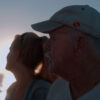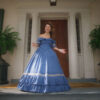In the year since Lotfy Nathan first unveiled his debut “12 O’Clock Boys” to a near rapturous response at SXSW in Austin, Texas last year, he has traveled the globe with the documentary about the dirt-bike riding African-American community of Baltimore, introducing their high-flying hijinks to audiences in Australia and Russia.
“It’s funny because it didn’t seem exotic to me anymore, [because] I spent enough time [with them],” says Nathan, who had worked on “12 O’ Clock Boys” for the last four years. “But this past year has reminded me that it is that. Maybe it sparks something of the initial interest that I had in other people.”
Credit for that may not only go to the lively Baltimore bikers, who eschew the rules of the road to take over the city’s streets en masse, but the way Nathan presents them in a similarly incendiary fashion as he primarily follows a young boy named Pug as he seeks entry into the titular crew. The first-time filmmaker doesn’t sit on the sidelines as the 12 O’ Clock Boys ride high, burrowing himself into the pack with his camera and catching all of the visceral thrills that come with it, but he also keeps perspective in the low-income neighborhood he likens to “parts of remote towns outside of Cairo” nearly reduced to rubble where opportunity is limited and creative outlets become precious.
For the British-born Nathan, who jokes he lost his accent “on the school bus” when he moved to America at 10, the project also allowed him to find an ideal way to channel his creativity, watching what was initially conceived as a video piece for a documentary class grow into a ferocious portrait of a fascinating subculture. Shortly before the film opens across the country, Nathan took the time to talk about how he first stumbled onto the 12 O’Clock Boys, relishing his status as a first-time director and getting in trouble with the law over filming.
I was going in school in Baltimore, studying painting at Maryland Institute College of Art. I’m not from Baltimore originally, so I think that added to my intrigue when I saw these guys riding around the city, maybe a few times over the course of my first few years living in Baltimore. I finally approached them with the camera. I was very wary at first, but they were very receptive to being filmed, so it just barrel rolled from there. It was a matter of exchanging phone numbers and getting more acquainted and then the project got bigger.
The way that you both were able to give dignity to them while portraying the danger of what they’re doing is quite striking. Was it a difficult thing to balance?
It required a lot of sensitivity on the editor’s part, and he was great. Thomas Niles was cutting his teeth on this film, [his first] where he was really in the drivers seat, but that was something I was juggling with as I was filming and as I was getting to know them more. I was seeing the consequence and the danger and the emptiness of it sometimes because it’s fleeting. The freedom, or the sense of freedom that they get is limited.
You actually get the sense that the camera is liberating for them because they’re able to broadcast themselves to the world on YouTube, in both what tricks they perform and also when you see a police beating stop because an iPhone is there to document it. Was that something you thought about as you were filming?
That’s something that I’m thinking about always now. The way that social media functions as well, now, the most dynamic and used forms of social media are about a quick-fix or validation for an image of yourself, or something that presents your personality. It’s like everyone feeds off of that. Everyone is a creator to that level. Instagram, you put something out there and you get these likes and it’s very warm and the ability to show disapproval and to complain and to protest online and to protect yourself. Everybody takes part in it. It’s the same as Yelp, actually.
Did you see this as a collaborative film? Of course, you do utilize footage shot by the 12 O’ Clock Boys themselves.
It matched the concept of the film and the approach. Even in terms of perspective, we tried to give perspective to Pug. With documentary, you can do that in a very tactile, very real way because people film themselves and you can make that authentic. There’s nothing like knowing that the first person view you’re looking at is actually the character, which can only exist in documentary.
I read you didn’t think this would take anywhere near as long as it did, but Pug’s maturation becomes the spine of the film. How did what you end up with compare with what you initially had in mind?
It’s like being stuck in an elevator for four years. It’s funny because it started off very passive, and I think you can see this in the movie itself two-thirds of the way through, there’s more steering what’s going on in the story. I couldn’t have imagined what it was going to be. For documentary, it’s a character is delivered through change over time, by definition. It has to take time. Someone can change a lot in a day, but it’s hard to get all of that, so you just have to keep going until you’re starting to see change and you also push that and accentuate that change in the editing. It was a long learning process, and I can really say I learned the ropes of that kind of independent filmmaking.

Yeah, but even that was a lot of push and pull because I didn’t like talking head interviews. It’s a fine line. We interviewed Department of Transportation, the police department, Department of Public Affairs, city council members we went to town hall meetings, interviews with victims. Ultimately, it was the verite moments and the real moments that spoke to me more.
When I started the editing with Thomas, there was maybe like 250 hours of footage. I had a messy assembly of two hours of Pug and his family and [about] two hours of the dirt bike riders and culture. I knew that we needed to finesse those together. In terms of balance and proportion, what note to stop on and what note to start on, it was really a lot of Thomas’ great work.
Stephen, the guy in the van who films the 12 O’Clock Boys, has this really clear-eyed perspective of what is going on. How did you meet him and did he serve as a guide to you as he does in the film?
I met him pretty early on through YouTube. [In] 2008, I saw he had this YouTube page where he was filming all this really dynamic action stuff with a camera phone and a little handycam out of his truck. He seemed to be in the middle of the whole group and it was incredible. I wrote him, we met at a car wash in East Baltimore, I got in his truck and the rest is history.
Ultimately, what he was saying was so sincere, I think that really helped. When we were editing, I was trying to reduce all these people who I’d gotten to know still into characters. We were calling Stephen, comparing [him to] Charon the Ferryman of Hades in Greek mythology, who carries the souls of the newly deceased across the river. He brings you into hell. Not that [Baltimore] was hell, but he had this great wisdom and he’d seen it and retired from it, but still reports there.
Did you actually ever get on a bike to shoot?
Sometimes. For the most part it was filming out of Stephen’s truck.
Was there a particularly crazy day of shooting?
There’s a shot in the film where you see this guy, Kevin, at night on top of a four-wheeler, and the camera goes up to him and then slightly below his head and you see this police helicopter light shine into the camera, which is one of my favorite shots that I’ve ever gotten. But that night, Stephen and I both got a court summons for the Baltimore Police for filming illegal activities, so that was a crazy day for us because the police were starting to take note of this truck that was trying to film what was going on. It was kind of a grey offense because there is certain illegal activity that you can film and be an accessory to, despite virtue of filming. But this is something that really is going on all the time.
Was this four straight years of filming?
It wasn’t four years of straight filming. In fact, to be honest, I really tried to run away from it at the end of every summer and say that it was done.
What kept you coming back?
What I had was a real piece of work that I was really passionate about. I felt that it was bigger than me. That was a reason to keep going. I felt it was bigger than me, yet I was trying to hold it up. Very talented, dedicated people also came and did the same. That just made it even stronger.
What drew you to taking that documentary class in the first place?
I really have no idea. I wasn’t figuring it out with paintings.
Does this form make more sense to you?
Yeah, it does. I’m a failed artist.
I think you’re an artist as is. You’re probably the worst person to ask this, but do you think the fact that you and a lot of your crew, including your editor and composer, were also first-timers helped create something different from a lot of other movies?
Absolutely, yeah. It’s something I’m kind of worried [about]. It’s so easy to unlearn, like why some people have only one good record, or something like that. You don’t know how hard it is until you’re finished. You can exploit yourself, not knowing how hard it is. The danger is if you become to wary afterwards, too exhausted to do it again. But that resourcefulness when you have limited means, when you’re starting out, you’re proving yourself. You’re outside society. In the middle of the summer in Baltimore, this was all I had sometimes. I look back on that really fondly.
“12 O’Clock Boys” opens in limited release and will be available on VOD and iTunes on January 31st. A full list of theaters and dates can be found here.






Comments 2